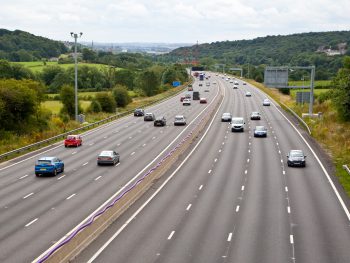No errors in smart motorway safety analysis but more data needed, says regulator
Government analysis on the safety of smart motorways have been backed by the road and rail regulator, but it’s called for more data to evaluate the performance of such schemes.

The ORR review said there were no errors in the review of smart motorway safety
The report has been provided by the Office of Road and Rail (ORR) in response to a request from Transport Secretary Grant Shapps earlier this year to undertake quality assurance of the data and evidence underpinning the conclusions arrived at regarding “all lane running” (ALR) motorways, which are a type of smart motorways.
The analysis came on the back of a review announced by the Department for Transport in October 2019 after a BBC Panorama special found 38 people have been killed on smart motorways in the last five years.
The analysis commissioned by the Transport Secretary found that overall smart motorways are in most ways as safe as, or safer than, conventional ones. Data showed that the risks that are lower on smart motorways compared with conventional motorways include tailgating, rapid changes of vehicle speeds, vehicles drifting off the carriageway and vehicles being driven too fast.
This was underscored by National Highways’ (previously Highways England) Smart Motorways Stocktake First Year Progress Report 2021 earlier this year, which included latest data indicating again that smart motorways are safer than conventional motorways.
In its review, the ORR said it had found that “all the data that was available for analysis have been used” and it found “no errors in underlying calculations, for example formula errors in spreadsheets used to process raw data”.
But it said there was a limited amount of data available. In 2019, there were only 141 miles of ALR motorway, the network having expanded from 29 miles in 2014. This means that only 29 miles of ALR has a full five years’ worth of data associated with it, and much less data are available for the remaining 112 miles.
ORR added: “The data have been collected over a relatively short time and there are few data points given the low frequency of incidents. Therefore, trends are volatile and highly sensitive to change when new data become available.”
It also made a number of recommendations to help strengthen the data and analysis used and also how risks can be managed.
And the ORR found that the risk modelling used could benefit from more effective use of different data and said National Highways should undertake additional forms of risk analysis to complement the approach taken.
The AA said it welcomed the further analysis of the performance of smart motorways.
Edmund King, AA president, added: “The ORR report shows that there was a ‘limited amount of data available’, so it is perhaps difficult to fully evaluate the performance of ‘smart’ motorways, hence it will be essential to have continuous monitoring and evaluation.”
And he continued: “We believe that controlled motorways with a hard-shoulder are the safest option and for other stretches, installing more emergency laybys on the existing network, in our view, will help improve both safety and driver confidence.
“Analysis shows that the forecast benefits have not been realised in some places, resulting in slower journey times, lower speeds and lower levels of economic benefit compared to assumptions.”
King also welcomed the news that the investigations into the M6 and M1 collision hotspots, raised by the AA with the Department for Transport and National Highways several years ago, have now been completed and action will be taken to help reduce collisions.
Earlier this year, the Government said no more smart motorways would be deployed in the UK without additional safety measures being put in place from the outset.
It committed to having radar-based Stopped Vehicle Detection (SVD) technology installed first across all new all-lane running schemes to detect stopped cars or broken-down vehicles quickly. The plans also set out that all existing ALR motorways would have the radar technology fitted six months earlier than originally planned.
Smart motorways have frequently been in the headlines in 2021, including in January when an inquest into the deaths of two people on a smart motorway section of the M1 motorway saw the coroner David Urpeth call for a smart motorway review, saying motorways without a hard shoulder carry “an ongoing risk of future deaths”.
And in February 2021, a coroner decided to refer Highways England to the Crown Prosecution Service (CPS) for a possible charge of corporate manslaughter following the death of a 62-year-old woman on a stretch of smart motorway.













Martin Evans08. Sep, 2021
So once again analysis shows Smart Motorways are at least as safe as ordinary motorways and probably safer.
Some people just don’t understand the risks of ordinary motorways and assume no hard should means less safe…probably the same people that get out of their car and change an off-side wheel on a hard shoulder…